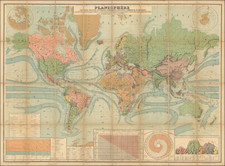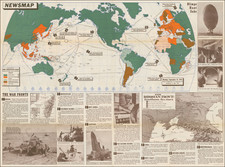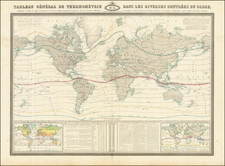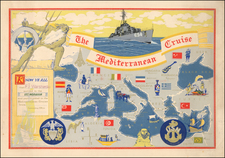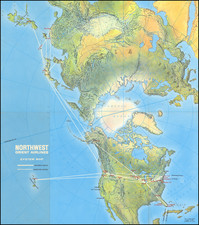Sectional view of the "subterranean" earth, showing internal magma and volcanic action at the surface, from Athanasius Kircher 's Mundus Suberraeneus.
Kircher was a Jesuit priest and contemporary of Galileo. His Mundus Subterraneus, an encyclopedic survey of the subterranean or "hidden" world was the first serious effort to describe the physical makeup of the earth, proposing theories (sometimes fantastic) in the areas of physics, geography, geology, and chemistry. It was, in part, based on Kircher's observations of the eruption of Vesuvius in 1637 and the two weeks of earthquakes that shook Calabria in 1638. He suggests the existence of a vast network of underground springs and reservoirs, as well as the theory that subterranean temperatures increase directly in proportion to depth.
The image shows a cross-section of the earth' s interior with its magma core and underground water sources. The surface of the earth is shown with erupting volcanoes and ships sailing in the oceans. The sphere issurrounded by clouds and six wind-heads. Two decorative title cartouches complete the fanciful composition.
Athanasius Kircher (1601-1680) was a Jesuit priest and a well-respected scholar known for his role in disseminating knowledge. Kircher was educated in Greek, Hebrew, and the humanities at Fulda, Paderborn, Cologne, Koblenz, and Mainz. After fleeing the Thirty Years’ War in Germany, Kircher worked as an academic at Avignon and, from 1634, Rome.
In Rome, Kircher served as an intellectual node, spreading information sent from around the world by Jesuit missionaries. Particular interests included ancient Egypt, astronomy, mathematics, medicine, music, and languages (both ancient and modern). He also made several maps and was a geographic compiler. It is likely he was the first person to depict the Pacific Ring of Fire on a map.
Kircher combined a mixture of hermeticism with nascent scientific inquiry, gaining him a reputation as one of the final Renaissance men. For example, he observed the eruptions of Etna and Stromboli. He had himself lowered into the crater of Vesuvius soon after an eruption to observe the changes wrought by the cataclysm. He experimented with bioluminescence by seeking the applications of firefly extract as a light source. He also made the first known Aeolian harp.
Kircher wrote 44 books, while over 2,000 of his manuscripts and letters survive. He also assembled one of the first natural history collections, the Museo Kircheriano or the Kircherianum, which was broken up after his death and became the foundation of several institutional collections.









![(Mississippi Bubble) De inbeelding, heersseres van 't rookverkopers-gild, maald Missisippi hier 't geen vrankryks schat verspild
[Imagination, ruler of the tobacco sellers' guild, grinds here what France's wealth wasted: the Mississippi.]](https://storage.googleapis.com/raremaps/img/small/96272.jpg)
